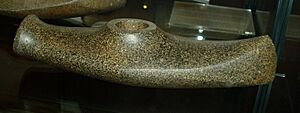Baltic paganism facts for kids
Baltic Paganism refers to the ancient religions and beliefs of people living in the Baltic countries. These beliefs existed before Christianity became common. Some people still practice parts of these old religions today.
While each Baltic religion had its own special features, they also shared many similar ideas. Like Scandinavian and Finnish pagans, Baltic pagans believed in a powerful male god of the sky and thunder. This god often carried a hammer or axe that created lightning.
This belief system is very old. Experts think it might have started in the Stone Age with the Corded Ware culture. People from this culture lived in a large area. They might have seen a boat-shaped stone axe as the weapon of their thunder god. Many traditions of Nordic and Baltic people come from this ancient culture.
Contents
What is Baltic Paganism?
Baltic Paganism is a group of old religions from the Baltic region. These countries include Lithuania, Latvia, and parts of Estonia. Before Christianity arrived, people in these areas followed these nature-based faiths. They believed that spirits lived in everything around them. This included trees, rivers, and even the sky.
These religions are called "pagan" because they are not one of the main world religions. They are often linked to nature and ancient traditions. While they share many ideas, each tribe or group had its own unique practices.
Ancient Beliefs in the Baltics
The roots of Baltic Paganism go back thousands of years. Some ideas might even come from the Stone Age. The Corded Ware culture is one ancient group linked to these beliefs. They lived in a wide area of Europe. Many features of Nordic and Baltic cultures come from this group.
People in the Baltic region lived close to nature. Their beliefs often focused on the cycles of the seasons. They honored the sun, moon, and stars. They also respected the land, forests, and water. This deep connection to nature was central to their spiritual lives.
Gods and Goddesses of the Baltics
The most important god in Baltic Paganism was often a sky and thunder god. He was seen as the most powerful deity. This god was believed to control the weather, especially storms. He was often shown with a powerful weapon. This weapon could be a hammer or an axe. It was thought to create lightning and thunder.
This thunder god has different names in different Baltic languages. For example, in Lithuanian, he is called Perkūnas. In Latvian, he is Pērkons. He is very similar to Thor in Norse mythology. He is also like Zeus in Greek myths or Jupiter in Roman myths. These gods all share the role of a powerful sky deity.
Besides the thunder god, there were many other gods and goddesses. These deities looked after different parts of life. Some were gods of the sun, earth, or water. Others protected homes, families, or animals. People would offer prayers and gifts to these gods. They hoped for good harvests, health, and protection.
How People Practiced Their Faith
Baltic pagans often held ceremonies outdoors. They would gather in sacred groves or near special trees. Rivers, lakes, and hills were also important places for worship. These natural spots were seen as holy. They were places where people could connect with the gods.
Rituals often involved offerings. People might offer food, drinks, or other valuable items. These offerings were a way to show respect to the gods. They also asked for blessings or help. Festivals were held throughout the year. These often marked changes in the seasons. They celebrated harvests, solstices, and equinoxes.
Folk songs, stories, and dances were also a big part of their faith. These traditions passed down knowledge from one generation to the next. They taught about the gods, heroes, and the history of their people. Even today, some of these traditions are still remembered and celebrated.
Baltic Paganism Today
While Christianity became the main religion in the Baltic states, some pagan traditions survived. In recent times, there has been a renewed interest in these ancient beliefs. Some people are now trying to revive Baltic Paganism. They want to reconnect with their ancestors' spiritual heritage.
Modern Baltic pagans often focus on nature worship and traditional customs. They celebrate ancient festivals and honor the old gods. This revival helps keep the unique cultural identity of the Baltic people alive. It shows how old beliefs can still be important in the modern world.
See also
 In Spanish: Mitología báltica para niños
In Spanish: Mitología báltica para niños


